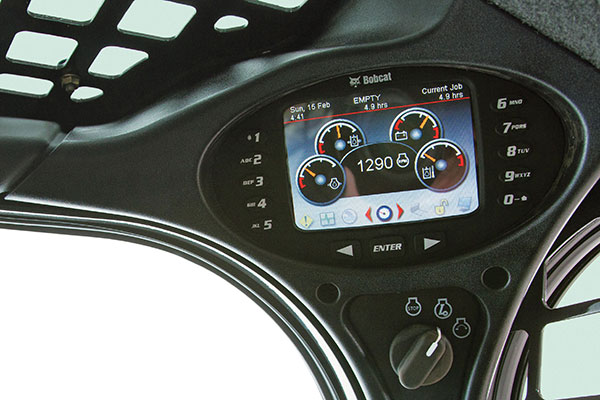
We are a nation that is always upgrading and innovating. As a result, the landscape of product development in many industries is changing.
Recent technological advancements in compact loaders are making the machines considerably more cost effective and environmentally friendly. Manufacturers are focusing on meeting your needs for highly productive machines and employees—because a more productive business is a more profitable one.
Instinctive Control Systems
What used to be a basic mechanically operated skid-steer or track loader is becoming a sophisticated machine capable of performing multiple tasks with modern controls. New control options are allowing owners to match operator preferences to jobsite needs. Joystick-type controls are becoming popular for their ability to place loader maneuverability and attachment commands at your fingertips. Operators of all ages are gravitating toward these improved controls, because they provide enhanced functionality with less fatigue.
Some of these controls also have built-in features that manage horsepower to match engine torque to your workload for efficient operation in many conditions. Such systems allow operators to manage their travel speed for more precise control of the machine. For construction jobs that involve multiple operators, many manufacturers’ control patterns can alternate between ISO and H-Pattern hand controls to match a particular operator’s preference, which helps to maximize comfort and efficiency.
Innovative Instrumentation
Loaders have also continued to evolve technologically in regard to instrumentation. The incorporation of simple yet advanced electronic systems inside the loader cab lets operators monitor a variety of activities from diagnostics and major loader functions to more in-depth machine and operator performance metrics.
 Bobcat M-series loader instrumentation panel
Bobcat M-series loader instrumentation panelSome current instrumentation systems can capture user data and statistics that allow job productivity and resources to be calculated for each operator. For example, some loaders now offer mechanisms that track individual fuel usage, real-time fuel consumption and idle time intervals. With this data, owners and fleet managers can assess a particular type of job and more accurately estimate what aspect of a job requires more fuel. If used routinely, this tool can help owners manage labor discrepancies.
Machine diagnostic and management technologies can also be integrated into some instrumentation systems to monitor engine temperatures and pressures along with attachment productivity. For instance, operators can consult their display panels to view job clocks, and cumulative hour meters can compute usage on high-output attachments such as planers and wheel saws. Certain systems can also equip owners to track parameters such as bit life, maintenance and total life of an attachment to assist with future purchasing or rental decisions.
Another benefit of instrumentation systems is their ability to help owners minimize the risk of loss due to theft or unauthorized use of a machine. Security features of many loader control technologies include a numeric keyless pad. Only operators with pre-assigned passwords can start and run the machine. In fact, theft protection is a leading concern on jobsites nationwide. According to the National Insurance Crime Bureau, U.S. business owners lose $3 million in stolen compact equipment daily. The use of keyless start systems may secure discounted insurance premiums on certain coverage plans.
With a growing number of businesses employing operators of different nationalities, language barriers may slow a crew’s productivity. This issue has prompted leading manufacturers to equip loader controls with operator instructions in multiple languages, which can reduce language barriers between operators and owners, or operators and supervisors. Panel readouts of leading loader control systems can be accessed in English, Spanish, French and several other languages, and this dialogue language is typically used throughout all panel communications including startup, machine and attachment operation, diagnostics and troubleshooting.
Emissions-Compliant Engines
New loader technologies extend to advancements in engines that reduce emissions and improve air quality. Compact loader manufacturers continue to take steps to comply with Environmental Protection Agency (EPA) diesel engine emissions standards such as the interim Tier 4 (iT4) and Tier 4 stages.
These federal mandates have already been introduced to on-highway trucking and automotive industries. To meet EPA requirements, manufacturers have introduced engine components like high-pressure common-rail fuel systems to maximize fuel delivery efficiency. They have also incorporated electronic control units to regulate fuel pressure and injection timing. These changes, combined with after-treatment systems including diesel particulate filter systems and diesel oxidation catalysts, are helping manufacturers meet new requirements.
Another outgrowth of iT4 and Tier 4 emissions implementation is the development of new oil specifications to lubricate these higher-performance engines. The CJ-4 oils and additive packages available on the market today are designed to reduce ash and help loader engines achieve a longer service life. The impact these oils have on compact loader maintenance will be evident as loaders begin to operate longer between changes, further reducing operational costs.
What’s the next frontier for compact loaders? Increased machine performance and efficiency, along with improved operator comfort, will be at the forefront of machine development. More efficient engines, hydrostatic drive and hydraulic systems will be used throughout the industry. Manufacturers will continue to focus on developing technologies that increase your utilization, cut operating costs and enhance your productivity.
